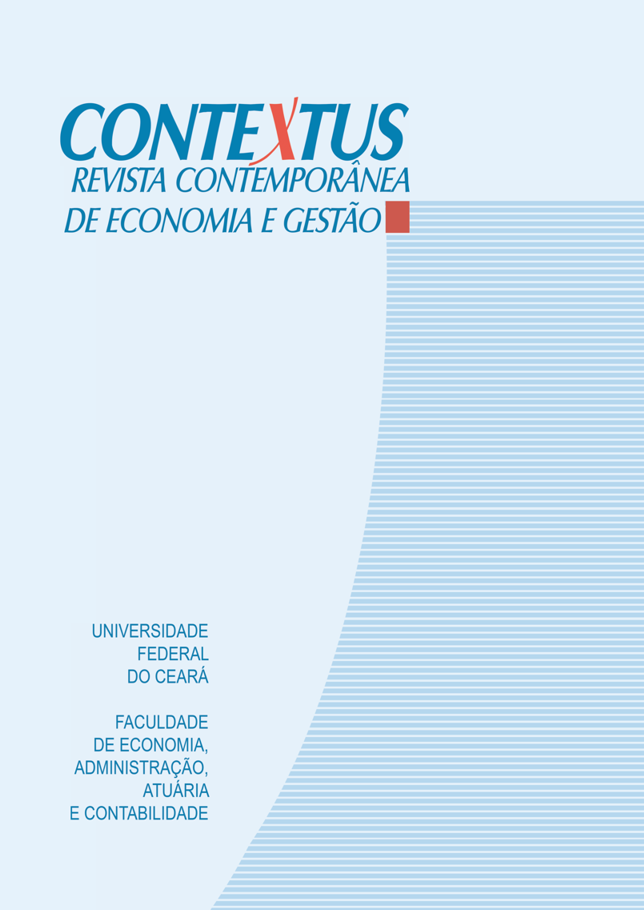Desinversión de activos, crisis económica y rendimiento futuro de las empresas
DOI:
https://doi.org/10.19094/contextus.2022.78644Palabras clave:
crisis económica, limitaciones financieras, rendimiento, inversiones, desinversionesResumen
La investigación analizó el impacto de las desinversiones de activos realizadas por empresas con limitaciones financieras en el rendimiento futuro, así como su potencial para revertir pérdidas pasadas. Luego de aplicar el emparejamiento de las empresas, se realizó la estimación de las relaciones de las variables a través de GMM y LOGIT. De esta investigación indican que existe evidencia de que la venta de activos por parte de empresas con restricciones financieras contribuye al desempeño futuro. Una contribución de esta investigación es para los administradores que tienen resultados empíricos que aún no han sido discutidos en la literatura brasileña y que pueden servir de apoyo en la toma de decisiones sobre la política de venta o mantenimiento de activos.
Descargas
Citas
Abu, S., Okpe, J., & Awen, B. (2021). Financial performance: does board monitoring committees matter? an empirical analysis of listed building material companies in Nigeria. Journal of Finance and Accounting, 9(1), 1-10. https://doi.org/10.12691/jfa-9-1-1
Akinyera, B. O. (2015). Too big to fail: A description and analysis of the causes, responses and effects of the 1890 Baring Bank’s Crisis and its comparison with the 2008 Lehman Brothers Banking Crisis. https://papers.ssrn.com/sol3/papers.cfm?abstract_id=2790546
Almaqtari, F., Al-Homaidi, E., Tabash, M., & Farhan, N. (2018). The determinants of profitability of indian commercial banks: A panel data approach. International Journal of Finance and Economics, 24(1), 168-185. https://doi.org/10.1002/ijfe.1655
Anderson, S. W. (2006). Managing costs and cost structure throughout the value chain: Research on strategic cost management. Handbooks of Management Accounting Research, 2, 481-506. https://doi.org/10.1016/s1751-3243(06)02001-3.
Aspara, J., Lamberg, J. A., & Tikkanen, H. (2015). Behavioral cycles leading to the divestment of previous core businesses. Academy of Management, 2015(1), 18106. https://doi.org/10.5465/ambpp.2015.282.
Barbosa, F. D. H. (2017). A crise econômica de 2014/2017. Estudos Avançados, 31, 51-60. https://doi.org/10.1590/s0103-40142017.31890006
Barney, J. (1991). Firm resources and sustained competitive advantage. Journal of Management, 17(1), 99-120. https://doi.org/10.1177/014920639101700108
Bhasa, M. (2015). Ownership structure and performance of listed state-owned enterprises vis-à-vis comparable private enterprises: Evidence from India. IUP Journal of Corporate Governance, 14(3), 7-24.
Campello, M., Graham, J., & Harvery, C. (2010). The real effects of financial constraints: Evidence from a financial crisis. Journal of Financial Economics, 97, 470-487. https://doi.org/10.1016/j.jfineco.2010.02.009
Cao, Y., Myers, L. A., & Sougiannis, T. (2011). Does earnings acceleration convey information? Review of Accounting Studies, 16(4), 812-842. https://doi.org/10.1007/s11142-011-9150-y
Carvalho, F., Maia, V., Louzada, L., & Gonçalves, M. (2017). Desempenho setorial de empresas brasileiras: Um estudo sob a ótica do ROE, Q de Tobin e Market to Book. Revista de Gestão, Finanças e Contabilidade, 7(1), 149-163. https://doi.org/10.18028/2238-5320/rgfc.v7n1p149-163.
Chen, P., & Zhang, G. (2007). Segment profitability, misvaluation, and corporate divestment. Accounting Review, 82(1), 1-26. https://doi.org/10.2308/accr.2007.82.1.1
Coad, A., & Rao, R. (2008). Innovation and firm growth in high-tech sectors: A quantile regression approach. Research Policy, 37(2008), 633-648. https://doi.org/10.1016/j.respol.2008.01.003.
Damasceno, F. (2019). Essays on information disclosure: Impairment theory, trade credit and voluntary disclosure behavior. (Doctoral thesis). Capixaba Institute for Research in Accounting, Economics and Finance Foundation – FUCAPE, Vitória, ES, Brazil.
Damodaran, A. (2009). Valuing young, start-up and growth companies: Estimation issues and valuation challenges. New York University - Stern School of Business, 2009(12), 1-67. https://doi.org/10.2139/ssrn.1418687
Davies, S., & Van Wesep, E. (2018). The unintended consequences of divestment. Journal of Financial Economics, 128(3), 558-575. https://doi.org/10.1016/j.jfineco.2018.03.007.
Dittmar, A., & Shivdasani, A. (2003). Divestitures and divisional investment policies. The Journal of Finance, 58(6), 2711-2743. https://doi.org/10.1046/j.1540-6261.2003.00620.x
Egbunike, C., & Okerekeoti, C. (2018). Macroeconomic factors, firm characteristics and financial performance – a study of selected quoted manufacturing firms in Nigeria. Asian Journal of Accounting Research, 3(2), 142-168. https://doi.org/10.1108/AJAR-09-2018-0029
Farmer, R. E. (2017). Prosperity for All: How to Prevent Financial Crises. Oxford University Press.
Fortunato, G., Funchal, B., & Motta, A. (2012). Impacto dos investimentos no desempenho das empresas brasileiras. Revista de Administração Mackenzie, 13(4), 75-98. https://doi.org/10.1590/S1678-69712012000400004
Franzotti, T. D. A., & Valle, M. R. (2020). The impact of crises on investments and financing of Brazilian companies: An approach in the context of financial constraints. Brazilian Business Review, 17(2), 233-252. https://doi.org/10.15728/bbr.2020.17.2.6
Fuertes-Callén, Y., & Cuellar-Fernádez, B. (2019). Inter-relationship between firm growth and profitability in a context of economic crisis. Journal of Business Economics and Management, 20(1), 86-106. https://doi.org/10.3846/jbem.2019.6928
Gimbert, X., Bisbe, J., & Mendoza, X. (2010). The role of performance measurement systems in strategy formulation processes. Long Range Planning, 43(4), 477-497. https://doi.org/10.1016/j.lrp.2010.01.001.
Giraudo, E., Giudici, G., & Grilli, L. (2019). Entrepreneurship policy and the financing of young innovative companies: Evidence from the Italian startup act. Research Policy, 48(9), 103801. https://doi.org/10.1016/j.respol.2019.05.010.
Gomes, B., Brugni, T., & Beiruth, A. (2021). Governança corporativa, agressividade fiscal e restrições financeiras no brasil. Contabilometria, 8(1), 36-54. http://fucamp.edu.br/editora/index.php/contabilometria/article/view/2130
Huang, Q. (2020). Ownership concentration and bank profitability in China. Economics Letters, 196(2020), 109525. https://doi.org/10.1016/j.econlet.2020.109525
Ibhagui, O. W., & Olokoyo, F. O. (2018). Leverage and firm performance: New evidence on the role of firm size. The North American Journal of Economics and Finance, 45, 57-82. https://doi.org/10.1016/j.najef.2018.02.002
Imeokparia, L., Adesanmi, D., & Olubukola, F. (2021). Effect of financial leverage on financial performance: A comparative study of deposit money banks and manufacturing companies in Nigeria. Global Journal of Accounting, 7(1), 37-46.
Jensen, M; Meckling, W. (1976). Theory of the firm: Managerial behavior, agency costs and ownership structure. Journal of Financial Economics, 3(1), 305-360. https://doi.org/10.1016/0304-405X(76)90026-X
Kanwal, S., & Nadeem, M. (2013). The impact of macroeconomic variables on the profitability of listed comercial banks in Pakistan. European Journal of Business and Social Sciences, 2(9), 186-201.
Klapper, L. F., & Love, I. (2002). Corporate governance, investor protection and performance in emerging markets. World Bank - Development Research Group. https://doi.org/10.2139/ssrn.303979
Klapper, L., & Love, I. (2011). The impact of the financial crisis on new firm registration. Economics Letters, 133(1), 1-4. https://doi.org/10.1016/j.econlet.2011.05.048
Kolev, K. (2016). To divest or not to divest: A meta-analysis of the antecedents of corporate divestitures. British Journal of Management, 27(1), 179-196. https://doi.org/10.1111/1467-8551.12145
Konara, P., & Ganotakis, P. (2020). Firm-specific resources and foreign divestments via selloffs: Value is in the eye of the beholder. Journal of Business Research, 110, 423-434. https://doi.org/10.1016/j.jbusres.2020.01.050
Leaño, M., & Pedraza, A. (2018). Ownership concentration and market liquidity: evidence from a natural experiment. Economics Letters, 167, 56-59. https://doi.org/10.1016/j.econlet.2018.02.024
Lee, S. (2014). The relationship between growth and profit: evidence from firm-level panel data. Structural Change and Economic Dynamics, 28, 1-11. https://doi.org/10.1016/j.strueco.2013.08.002
Lee, S. (2018). Growth, profits and R&D investment. Economic Research - Ekonomska Istrazivanja, 31(1), 607-625. https://doi.org/10.1080/1331677X.2018.1432380
Lima, F. G., Assaf, A., Neto, P., Perera, L. C. J., & Silva, A. D. (2011). The impacts in the capital structure of Brazilian companies during periods of crisis. Journal of International Finance and Economics, 11(2), 154-160.
Loss, L., & Sarlo, A., Neto (2006). O inter-relacionamento entre políticas de dividendos e de investimentos: Estudo aplicado às companhias brasileiras negociadas na Bovespa. Revista de Contabilidade e Finanças, 17(40), 52-66. https://doi.org/10.1590/S1519-70772006000100005
Miranda, M., Ferreira, M., Abrantes, L., & Macedo, S. (2022). Effects of Tax Exemption on Economic Growth. Brazilian Business Review, 19(2), 1-18. https://doi.org/10.15728/bbr.2021.19.2.4
Nassif, A. (2017). An analysis of brazil’s economic situation: 2014-2017, the short-term outlook and policy alternatives. Brazilian Keynesian Review, 3(1), 95-108. https://doi.org/10.33834/bkr.v3i1.106
Paula, L. F. D., & Pires, M. (2017). Crise e perspectivas para a economia brasileira. Estudos Avançados, 31, 125-144. https://doi.org/10.1590/s0103-40142017.31890013.
Paunov, C. (2012). The global crisis and firms’ investments in innovation. Research Policy, 41, 24-35. https://doi.org/10.1016/j.respol.2011.07.007
Pinto, A., Augusto, M., & Gama, P. (2011). Determinantes da relação bancária e restrições de crédito nas PME Portuguesas. http://hdl.handle.net/10400.19/2371
Rabinovich, J. (2021). Financialisation and the ‘supply-side’face of the investment-profit puzzle. Journal of Post Keynesian Economics, 44(3), 434-462. https://doi.org/10.1080/01603477.2020.1734463.
Rajan, R. G., & Zingales, L. (1995). What do we know about capital structure? Some evidence from international data. The journal of Finance, 50(5), 1421-1460. https://doi.org/10.1111/j.1540-6261.1995.tb05184.x
Ross, S. A. (1995). Uses, abuses, and alternatives to the net-present-value rule. Financial Management, 24(3), 96-102. https://doi.org/10.2307/3665561
Sant’Anna, D. P., Louzada, L. C., Queiroz, E., & Ferreira, B. P. (2015). Valor de mercado e valor contábil e sua relação com os resultados anormais no mercado de capitais no Brasil. Revista de Contabilidade e Organizações, 9(23), 3-13. https://doi.org/10.11606/rco.v9i23.61873
Sarjono, E., Titisari, K. H., & Pawenang, S. (2021). Effects of infrastructure development, inflation and economic growth to performance company (ROA, Tobin's Q, PBV): Study on registered infrastructure support companies in IDX period 2014-2019. Economics and Business Quarterly Reviews, 4(3).
Scherer, F. (1965). Corporate inventive output, profits, and growth. Journal of Political Economy, 73(3), 290-297.
Shaikh, A. (1978). An Introduction to the history of crisis theories. Review of Radical Political Economics, 219-241.
Shaikh, I. A., & O’Connor, G. C. (2020). Understanding the motivations of technology managers in radical innovation decisions in the mature R&D firm context: An Agency theory perspective. Journal of Engineering and Technology Management, 55, 101553. https://doi.org/10.1016/j.jengtecman.2020.101553.
Souza, J. D. M., Montezano, R. M. S., & Lameira, V. J. (2020). Os impactos dos investimentos em ativos reais no desempenho de empresas brasileiras. Revista Contabilidade Vista & Revista, 31(3), 6-25. https://doi.org/10.22561/cvr.v31i2.4868
Swalih, M., Adarsh, K., & Sulphey, M. (2020). A study on the financial soundness of ndian automobile industries using Altman Z-Score. Accounting, 7(2), 295-298. https://doi.org/10.5267/j.ac.2020.12.001
Taouab, O., & Issor, Z. (2019). Firm performance: definition and measurement models. European Scientific Journal, 15(1), 93-106. https://doi.org/10.19044/esj.2019.v15n1p93
Whited, T. M., & Wu, G. (2006). Financial constraints risk. The Review of Financial Studies, 19(2), 531-559. https://doi.org/10.1093/rfs/hhj012.
Wiersema, M. F., & Bantel, K. A. (1993). Top management team turnover as an adaptation mechanism: The role of the environment. Strategic Management Journal, 14, 485-504. https://doi.org/10.1002/smj.4250140702
Zylbersztajn, D. (1995). Estruturas de governança e coordenação do agribusiness: Uma aplicação da nova economia das instituições. (Doctoral thesis). University of São Paulo – USP, São Paulo, SP, Brazil. http://www.fundacaofia.com.br/pensa/anexos/biblioteca/63
Descargas
Publicado
Cómo citar
Número
Sección
Licencia
The authors, while doing the submission, accept the notice below:
We authors hold the copyright related to our paper and transfer Contextus journal the right for the first publication with a Creative Commons’ international license of the modality Attribution – Non-commercial 4.0, which in turn allows the paper to be shared providing that both the authorship and the journal’s right for initial release are acknowledged.
Furthermore, we are aware of our permission to take part in additional contracts independently for non-exclusive distribution of the version of our work published in this journal (e.g. publishing it in an institutional repository or as a book chapter), while acknowledging both the authorship and the journal’s initial publication.
We also certify that the paper is original and up to this date has not been released in any other journal, Brazilian or of another nationality, either in Portuguese or another language, as well as it has not been sent for simultaneous publication in other journals.
Last, we not only know that plagiarism is not tolerated by Contextus but also certify the paper presents the sources of passages from cited works, including those authored by ourselves.










1.jpg)



1.jpg)

1.jpg)



.jpg)



1.jpg)

1.jpg)


1.jpg)

1.jpg)
1.jpg)
2.png)




2.jpg)
1.jpg)




1.jpg)


1.jpg)
1.jpg)
